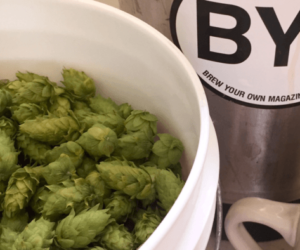How to Remove Trub
Trub is chemically composed of proteins, tannins, hop compounds, and fatty acids. Physically it appears in the wort as amorphous little bits of beige matter. Hot break refers to trub that precipitates during the boil at temperatures above 212° F (100° C). Cold break describes trub that starts to form at 72° F (60° C) and continues to form as the temperature grows colder.
Between the boil and fermentation try to remove most of the trub. You’ll end up with a cleaner-tasting beer. High levels of trub may cause off characters in the beer, such as sulfur compounds and fusel alcohols.
A poor break may also cause haziness in the finished beer as well as an increased stalling potential due to a higher tannin content. A high amount of trub in the yeast will decrease its vitality if the yeast is to be repitched into another beer. Removing trub is particularly critical for lager beers, because off-flavors are more easily perceived in lagers.
When It’s Hot
Several methods help remove hot-break trub.
Boil vigorously to help coagulate protein-tannin complexes.
Skim the sludge off the top of the foam during the boil.
Add Irish moss to the boil. This fining agent, which is derived from seaweed, reacts with the proteins in the wort, encouraging them to form trub. Irish moss may be added 15 minutes before the end of the boil.
Whirlpool the wort. Whirlpooling is the process of running wort into a cylindrical vessel at an angle that causes the wort to stream around the inside of the vessel (as opposed to filling up from bottom to top). As the hot wort moves in a circular motion, the trub and spent hops form a cone in the center. The wort is then decanted off of the solids and cooled. This may be difficult for homebrewers, since a whirlpool would require designing a new piece of equipment. Furthermore, the hot wort should enter the whirlpool at a high speed. Gravity flow may not develop enough speed to facilitate a good break.
A simple alternative is to stir the entire wort in a circular motion with a sanitized spoon for a few minutes, then cover and allow the solids to settle for 10 minutes. The clear wort can then be racked off of the solids into another vessel, where it can be cooled with an immersion chiller. An immersion chiller also can be carefully placed directly into the kettle so that the break on the bottom is not stirred up. The beer can then be cooled and racked.
Use a hopback. A sieve or hopback is basically a rough filter to remove trub and impart hop aroma. The hot wort along with whole hops is run into a vessel with a false bottom or straining device. As the wort flows through the bed of hops, the trub particles are filtered out. The hot wort can be run from the kettle through the hopback into another vessel with an immersion cooler in place. The cooled beer can then be racked off the cold break that forms during cooling.
When It’s Cold
To remove cold-break material, try these methods.
Settle in the kettle and rack.
This method calls for cooling the beer in the kettle and allowing hot-break and some cold-break material to settle out. The cooled wort is then carefully drawn off the trub. This method allows much of the cold-break material through to the fermentation, since it will continue to form as the beer continues to cool.
Use a sedimentation vessel.
This is possibly the easiest and most effective method of removing cold break. After the wort is cooled, it can then be racked into an empty sanitized carboy. The trub should be allowed to settle and the wort should be racked again into a vessel for pitching and fermentation.
Use flotation. This method of removing cold-break trub also oxygenates the wort. After the wort is cooled, it is racked out of the kettle and into a second sanitized vessel. Here it is aerated from the bottom with a line from a fish tank aerator or air compressor. To avoid contamination an in-line air filter can be constructed or purchased from a medical supply house. As the tiny air bubbles float to the surface, the trub particles hitch a ride and settle at the top of the foam, where they can be skimmed off.
How Much to Remove?
For the homebrewer separating trub can be a trade-off between removing the goopy stuff and risking contamination during the sensitive period between the boil and the start of fermentation. Many of the techniques that remove trub can also expose the wort to contamination if careful sanitation is not practiced. Absolute trub removal is not only unnecessary, it actually produces a less active fermentation. A small amount of trub will provide much-needed fatty acids for the yeast. Using a combination of the above methods should remove enough trub to avoid off-flavors while still providing adequate fatty acids for a healthy fermentation.



